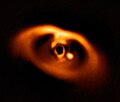
A super-puff is a type of exoplanet with a mass only a few times larger than Earth's but with a radius larger than that of Neptune, giving it a very low mean density. [1] They are cooler and less massive than the inflated low-density hot-Jupiters. [1]
The most extreme examples known are the three planets around Kepler-51 which are all Jupiter-sized but with densities below 0.1 g/cm3. [1] These planets were discovered in 2012 but their low densities were not discovered until 2014. [2] Another example is Kepler-87c. [1]
One hypothesis is that a super-puff has continuous outflows of dust to the top of its atmosphere (for example, Gliese 3470 b), so the apparent surface is really dust at the top of the atmosphere. [2] Another possibility is that some of the super-puff planets are smaller planets with large ring systems, like HIP 41378 f. [3]
A 2026 study theorized that super-Earths and sub-Neptunes are puffy when they are young but shrink in size over time. [4] [5]
Formation hypotheses
The anomalous mass-to-radius ratio of super-puff planets was first interpreted as evidence for the presence of substantial hydrogen-helium envelopes formed billions of years ago within the protoplanetary disk. [6] [7] [8] In this long-term formation scenario, such envelopes would be prone to erosion through atmospheric escape processes, suggesting that maintaining extremely low densities over gigayear timescales would be difficult. [9] [10] [11] [12] [13] The persistence of known super-puffs has therefore motivated alternative models of envelope formation and retention.
